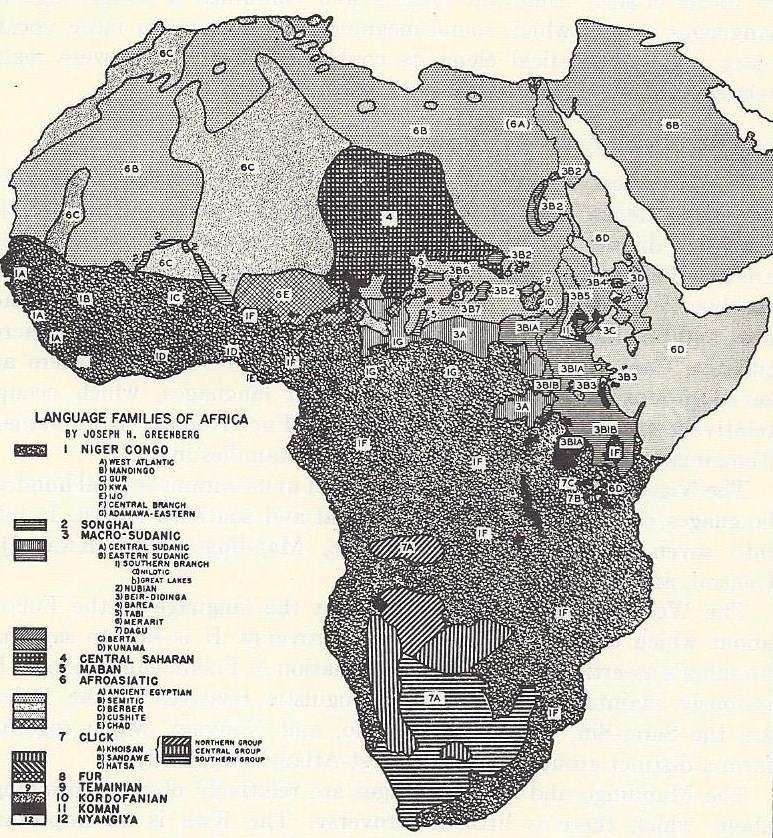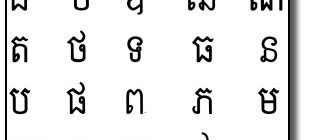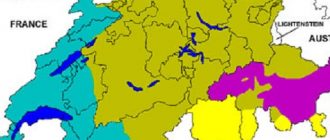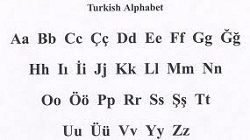The classification outlined here is founded on a review of the total African evidence in which only the criteria relevant in the light of the foregoing discussion are considered.
According to this scheme, there are five distinct language families of major importance on the African continent. They occupy perhaps 98 per cent of the total precontact area and population. These are:
- The Niger-Congo;
- Afro-Asiatic;
- Macrosudanic;
- Central Saharan, and Click families.
In addition, there are seven groups of languages, or individual languages, which occupy relatively small areas:
- Songhai;
- Maban;
- Fur;
- Koman;
- Kordofanian;
- Temainian, and Nyangiya. Making twelve families in all.
Niger-Congo Language Family
The Niger-Congo family is of vast extent and contains several hundred languages covering most of west central and southern Africa. It falls into seven subfamilies:
- West-Atlantic;
- Mandingo;
- Gur;
- Kwa;
- Ijo;
- Central;
- Adamawa-Eastern.
Fulani (Fula) language
The West-Atlantic subfamily includes the language of the Fulani, about which there has been much controversy. It is safe to say that Meinhof’s assertion of the Hamitic affiliation of Fulani can no longer be seriously maintained.
The closest linguistic relatives of the Fulani are the Serer-Sin, Wolof, Serer-Nono, and Konyagi, which together form a distinct group within the West-Atlantic subfamily.
Mandingo, Gur, Kwa and Ijo languages
The Mandingo and Gur languages are relatively obvious groupings about which there is little controversy. The Kwa is an important subfamily which stretches from Liberia, where the Kru languages are spoken, to the Edo (Bini) and Yala or Idoma group of southeastern Nigeria.
The Ewe, Twi, and Yoruba groups all are affiliated with Kwa as well as with the Togo remnant languages, formerly classified in a separate branch. Ijo is a language of southeast Nigeria which forms a group by itself.

Central group of the Niger-Congo Language Family
The Central group of the Niger-Congo family mainly consits of languages in Nigeria but contains the vast Bantu stock as a subgroup.
Within this Central branch, Bantu has a particularly close relationship to Tiv, Batu, Ndoro, Bitare, Mambila, and Jarawa.
Adamawa-Eastern group
The Adamawa-Eastern group includes many little-known languages in eastern Nigeria and the Cameroons, along with such important languages farther east as Azande and Sango.
Afroasiatic (Afro-Asiatic) languages
The Afro-Asiatic, like the Niger-Congo family, is of vast extent, covering all of northern Africa, adjoining portions of Asia, the Horn area of East Africa, and an extensive region in the vicinity of Lake Chad.
There are five branches:
- Berber;
- Cushitic;
- Semitic;
- Ancient Egyptian (extinct);
- Chad.
The Chad subfamily contains perhaps as many as a hundred languages found for the most part in northern Nigeria and the northern Cameroons. The best-known language of this group is Hausa, probably the largest speech community in Africa outside of Arabic and widely employed as a lingua franca in West Africa.
The Afro-Asiatic languages correspond in general to those included under the traditional term “Hamito-Semitic.”
“Hamitic” has in the past been a cover term for all non-Semitic branches and represents no real linguistic entity. In view of the serious misunderstandings occasioned by the use of this term in physical anthropology and culture history, it is abandoned in the present classification.
The Macrosudanic languages
The Macrosudanic languages are another major stock concentrated in the area of the Congo-Nile divide and extending eastward into the Upper Nile and northern Great Lakes region of East Africa.
There are four branches:
- Eastern Sudanic;
- Central Sudanic;
- Kunama;
- Berta.
The Eastern Sudanic group includes Nuba, the Nilotic languages, and the so-called Nilo-Hamitic languages (Masai, Bari, etc.).
Central Sudanic contains, among others, the Sara dialects near Lake Chad, Mangbetu, and the Moru-Madi subgroup.
Kunama is a language of northwestern Ethiopia, and Berta is the designation of a small number of languages straddling the Ethiopian-Sudanese border.
Central Saharan, and Click families
Central Saharan covers a large but generally sparsely settled territory north and east of Lake Chad and near the lake itself.
Included are Kanuri, Teda, and Zaghawa.
The Click family comprehends the languages of the Hottentots and the various Bushman populations of southwestern Africa as well as the Hatsa and Sandawe forms of speech farther north in East Africa. Here again, Meinhof’s theory of the Hamitic affiliations of Hottentot is not seriously maintained at the present time.
Hottentot is closely allied to the Bushman languages of the Naron and Auen, within the much larger Khoisan branch of the entire Click family.
In addition to the twelve families enumerated earlier, there is Malagasy, a Malayo-Polynesian language spoken on the island of Madagascar. Meroitic, the extinct language of Meroe, an Egyptian-influenced culture of the Blue Nile-White Nile area which flourished in classical times and is only imperfectly known from inscriptional remains, appears to be independent.
The Origin of Bantu
This review makes it clear that the present linguistic diversity of Africa cannot be reduced to a single source and that there has been a complex history of settlement over a very long period.
This should not be surprising.
Africa, on the evidence of paleontology, has been inhabited by hominids from very early times and rivals Asia as a possible home for earliest man. Some of the details of this long and varied historical development can, of course, be deduced from the language classification outlined here.
One salient problem is that of the place of origin of the large Bantu group of closely related languages which occupies practically all of the southern third of the continent.
The facts that Bantu is affiliated with the Central branch of the NigerCongo family and that the other languages of this group are all spoken in Nigeria and the Cameroons point strongly to this general area as the original Bantu homeland. The special relationship of Bantu, within the Central group, to Tiv, Batu, Ndoro, Bitare, Mambila, and Jarawa serves to make this hypothesis more explicit. Since all these peoples live in a relatively restricted area near the central Benue Valley, this particular region is strongly indicated as the point of origin of the Bantu migration.
The date at which such a proto-Bantu community still spoke a unified language may be estimated as approximately twenty-five hundred years ago. The hypothesis that the Bantu spread first into the Congo rain forest and then into East and South Africa at this relatively recent date is in general accord with the archeological and paleontological evidence, which suggests that the earlier population of this area was of the Bushman and Pygmy types.
Hitherto the prevailing view (strongly championed, for example, by Sir Harry Johnston) has been that the Bantu originated in the Great Lakes area of East Africa. The reason advanced has been that the Bantu languages of the East African lake area are more primitive in type than the other Bantu languages. What is presumably meant is that these languages have changed less from the parent Bantu language than others of the same stock. Scientific comparative linguistics rejects arguments of this kind.
Closer examination of such assertions usually reveals that a few striking archaisms have been noticed that the innovations ignored. We expect that in a group of related languages all will have changed approximately to the same degree from the ancestral language. Even assuming that the Great Lakes languages are more archaic, the conclusion that this area is the Bantu homeland by no means follows. Similar reasoning applied to the Romance languages might lead to the conclusion that Latin originated in Sardinia, where certain conspicuous archaisms are retained. It would certainly not lead to the conclusion that Latin originated in Rome.
On the other hand, the argument based on the geographical location of the genetically most closely related languages is a powerful one. It may be illustrated by the example of English. In the absence of written history, how could one choose among North America, South Africa, Australia, and the British Isles as the possible homeland of the English language? The language most closely related to English is Frisian, spoken by a small fishing population on the Dutch coast. The next most closely related languages are the Germanic group, found in northern Europe. Moreover, the remainder of the Indo-European family, of which Germanic is a branch, covers an adjacent area in Europe and western Asia.
Each step, therefore, strengthens the case for the British Isles as against the other possible areas. In similar fashion, the relationships of Bantu point first to the central Benue, then to the Central group of Niger-Congo in Nigeria and the Cameroons, and finally to the Niger-Congo family, whose distribution centers in West Africa rather than East Africa.The Great Lakes theory of Bantu origins has, at least in the minds of some of its adherents, been but one aspect of a general orientation which would, in its most extreme form, attribute virtually all the seminal events of African history to the stimulus of incoming, superior Caucasoids, both Semites and Hamites, as they exercised their influence on an indigenous, culturally passive Negroid population.
Thus the Bantu languages, according to one view, arose in the area of the Great Lakes as the result of contact between a basic Sudanic-speaking Negro group and a Hamitic people. In its racial aspect, this theory derives most of the population of sub-Saharan Africa, outside of a relatively small group of forest Negroes in West Africa, from varying Semitic and Hamitic admixture.
Hamitic Languages
The linguistic counterpart of this theory has been the widespread extension of the use of “Hamitic” as a linguistic term. Indeed, the racial aspect of the Hamitic theory has been largely influenced by its employment in linguistic classification, the historical antecedent.
The widest linguistic usage of the term “Hamitic” is found in Carl Meinhof’s writings.” He considers as Hamitic Fulani, Hausa, and other languages in West Africa, Hottentot in South Africa, and Masai, Nandi, and other cattle peoples of the so-called Nilo-Hamitic subfamily in East Africa, in addition to the generally accepted groups of Berber, Ancient Egyptian, and the Cushitic of east Africa. Others besides the present writer have pointed to the weakness of the case presented by Meinhof for the Hamitic affiliations of Fulani and Hottentot.
The Nilo-Hamitic group is still the subject of some controversy, but all writers agree that it is closely related to Nilotic, which would place it within the Macrosudanic family of the present writer. Some, however, maintain that it is a linguistic hybrid containing Hamitic elements. On the other hand, Hausa and the many other languages related to Nilo-Hamitic in the Chad group are now generally admitted to be members of the Hamito-Semitic family. It is an ironic fact that these, the only non-cattle peoples contained in Meinhof’s extension of traditional Hamitic, have also turned out to be the only valid addition to the family.
Finally, the view that Semitic and Hamitic are two branches of a Hamito-Semitic family can no longer be seriously maintained. The genetic picture that emerges from a careful review of the data is that of a linguistic family with five co-ordinate branches of which Semitic is but one. The term “Hamitic,” therefore, lacks any linguistic foundation, since it is a term traditionally applied to four of the five branches of the entire family. It was for this reason that the present writer suggested the term Afro-Asiatic in place of the misleading Hamito-Semitic. In the light of these considerations, the racial and cultural-historical Hamitic theory lacks a linguistic foundation.
Special Features of African Languages
Although we cannot prove an ultimate unity of all African languages, there are, just as in other aspects of African culture, features which set off Africa from other areas of the world. These result from later contacts among the languages of the continent, on a vast scale and over a long period.
Practically none of the peculiarities listed below as typical are shared by all African languages, and almost every one is found somewhere outside of Africa, but the combination of these features gives a definite enough characterization that a language, not labeled as such for an observer, would probably be recognized as African.
Among sounds, the clicks of the Click family and certain South African Bantu languages are not found anywhere else in the world. The simultaneous labiovelar kp and gb sounds are distributed over a wide east-west belt of languages of diverse genetic affiliations from the Atlantic Ocean almost to the Nile Valley. Outside of Africa, these sounds are only known from a restricted area of Melanesia both in Melanesian and in so-called Papuan languages.
Implosive consonant sounds, in which the lowering of the glottis produces a rarefaction of the air followed by the ingress of outside air, are frequent in Africa but uncommon elsewhere. With few exceptions, African consonant systems are simple, without the variety of back velar sounds occurring in other parts of the world.
Vowel systems are likewise simple, with the virtual absence of umlauted vowels or unrounded back vowels, the so-called abnormal vowels. Consonant combinations are usually few in number. They practically never involve more than two consonants medially or one initially. The syllable is characteristically open, that is, ending in a vowel. Initial ng sounds and initial combinations of nasal plus voiced stop, for example, mb and nd, are extremely common, and relatively rare elsewhere in the world.
Finally, tone is almost universal in Africa outside of the important Afro-Asiatic family. Even here, most-perhaps all-members of the Chad subgroup have tonal systems under the influence of neighboring languages. In morphology, complex noun classifications like the well-known prefix classes of Bantu are widespread, though far from universal. The same feature is found in aboriginal Australia and in New Guinea, but without specific points of resemblance. The verb very often has a complicated set of derivatives to express such ideas as the causative, reflexive, passive, or motion towards the speaker. Characteristically, these ideas may be combined with each other.
An example from Swahili will serve to illustrate such a system:
- pata (obtain);
- patana (make an agreement-reciprocal);
- patanisha (unite-reciprocal causative);
- patia (obtain for somebody-applicative);
- patika (be seized-passive);
- patiliza (make someone vexed-causative);
- patilizana (vex each other causative-reciprocal), etc.
In the sphere of semantics, there are many idioms or metaphorical uses of terms with wide distributions found infrequently or not at all outside of Africa.
Examples of such usages include the same term meaning “meat” and “wild animal”.
Еhe verb with the primary meaning “to eat” also meaning “to conquer,” “capture a piece in a game,” “have sexual intercourse”; the phrase “child of —” to express the diminutive; the phrase “child of the tree” meaning ”fruit”.
Widespread use of parts of the body to express position (cf. English “back of”), for example, “belly of” meaning “inside,” “head of” meaning “upon,” “buttock of” meaning “at the base of”; “he himself” often translates as “he with his head.”
A final example is the typical mode of expressing comparison in two variants-”x surpasses y in size” or “» is big, surpasses y” meaning “x is larger than y.”
Linguistic Areas of Africa
It is noticeable that various sections of the continent differ in the intensity with which they partake of such common characteristics.
There is a large central area in which all of these characteristics are found in most of the languages. This core area consists mainly of the Niger-Congo languages, Songhai, the Central Sudanic subgroup of the Macrosudanic family, and, to a certain degree, the Chad subgroup of Afro-Asiatic.
Other areas which can now be roughly delimited are marginal in that they partake of some but not all of these features. In addition to their imperfect sharing of the most widespread African characteristics, each displays specialized phenomena which result from linguistic contacts within the area itself.
One widespread area which can be described as marginal is the Khoisan-speaking part of southwestern Africa.
Another well-marked linguistic area embraces approximately Ethiopia and the various Somalilands.
The languages here are of heterogeneous origin-Cushitic, Ethiopian Semitic languages, Kunama, and Barca, the last two being members of different branches of Macrosudanic. This area is marked by relatively complex consonantal systems, including glottalized sounds, absence of tone, word order of determined followed by determiner, closed syllables, and some characteristic idioms. Another rather less well-marked area can be discerned in the northern part of East Africa and in the Nile Valley, containing the Nilotic, Great Lakes, and Didinga-Murle groups, all belonging to Eastern Sudanic, and the Moru-Madi group of the Central Sudanic subfamily of Macrosudanic.
North of the Nile-Congo divide a whole series of languages which diverge sharply from languages to the south stretches across the eastern Sudan from Lake Chad in the west. Included are the Central Saharan languages, Maban, Fur, and the Dagu, Merarit, and Nubian languages of the Eastern Sudanic subgroup of Macrosudanic. Characteristics of this area include periodic sentence construction with the use of participles for subordination reminiscent in structure of classical Latin, a case system in the noun but without adjective agreement, and the absence of noun classificatory systems.
It should be emphasized that these language areas are tentative and in need of further. investigation and documentation. A general resemblance to Herskovits’ standard culture-area classification is evident. The central or core area corresponds roughly to the Congo-Guinea Coast area, though it is somewhat more extensive, including especially the major part of the East Cattle area. The Khoisan area equates with the Bushman and Hottentot areas.
The Ethiopian area outlined alone practically coincides with the East African Horn. The region which consists of the Nilotic, Great Lakes, Didinga, and Morn-Madi languages embraces the northern portion of the Eastern Cattle area. The group of languages stretching across Africa east of Lake Chad agrees well with the Eastern Sudanic area. Finally, the Berber- and Arabic-speaking areas that cover the northern stretch, though very similar, fall into two portions.
In the western part of the area Arabic dialects, commencing approximately with the Egyptian-Libyan border, share many features derived from contact with Berber speakers, while Berber in turn contains large numbers of Arabic loan words and some sounds which have entered by way of Arabic influence. These two areas agree approximately with Herskovits’ Egyptian area and the undesignated North African area.
European Influences on African Languages
The languages of Africa, in their sharing of fundamental features underlying a complexity of origin and in their areal differentiation, agree in general fashion with other aspects of African culture. So, too, the long-continued and persistent Moslem influences, which have to a high degree shaped the life patterns of Negro peoples in the entire Sudan and much of East Africa and even farther south, find their reflection in the numerous loan words of ultimate Arabic origin, even among non-Moslem peoples.
What, then, of the European influences of the last several centuries which have transformed so many aspects of African life? The effects of these events on the linguistic life of Africa would probably have to be judged as relatively small, compared with that of Arabic. The essential continuity of African culture in spite of drastic changes is perhaps nowhere better illustrated than in language.
European contact has resulted in the importation of the large Afrikaans- and English-speaking populations of South Africa and much smaller or negligible European speech communities elsewhere. In the urban areas of Liberia and Sierra Leone, English in standard and Creolized form, respectively, has been established by repatriated Negro slaves. A few words, generally of Portuguese origin, have been borrowed for earlier items brought through the agency of Europeans, e.g., manioc from South America and the domestic pig in coastal areas (elsewhere it is older). In more recent times, borrowings have occurred chiefly from English and French for more modern items of contact, such as Hausa kantini (store), kwano (can), or sati (wages), from Saturday, the standard payday. Many borrowed terms of recent importation are not yet well established, and only the future will tell to what extent such words will continue or be replaced by indigenous expressions. The study of recent loan words of European origin is a field of great interest which has thus far hardly been investigated.
In addition, European languages have been used as lingua francas, particularly among educated Africans of differing tribal backgrounds, and as a vehicle of education, particularly on the higher levels. However, in all such cases except the Creolized forms already mentioned, European languages among Africans lack the basis provided by a large population speaking the language as its native tongue. Moreover, while serving in this fashion as a means of wider communication, such languages as English and French have to some extent been barriers to understanding:
Africans with English and French education have, along with the language, acquired differing British and French cultural values.
In summary, the total direct linguistic influence of European contact has been the introduction of a few new speech communities of European origin, the use of European languages as lingua francas, and the introduction of loan words comprising but a very minor portion of the total vocabulary of any African language. The effect of European languages on the grammatical structure of African languages, as far as can be seen, is virtually nonexistent. In another direction, however, the indirect effects are of greater import. Language differentiation is the reflex of over-all communication conditions. Before intensive European contact, there were occasional instances of the spread of single languages over wide areas as the result of political expansion or in response to economic needs. One instance is the wide distribution of the Malinke language in its various dialectal forms in French West Africa, an event which must surely be connected with the existence of the vast Mandingo Empire in this region in the Middle Ages. So, likewise, much of the spread of Hausa as a second language beyond its original borders was a pre-European response to the growing indigenous trade needs of this segment of the western Sudan.
One of the chief effects of European colonizing activity has been the widening of communication through the abolition of slavery and inter-tribal warfare and the development of roads, railroads, and other forms of transportation. The more widespread traveling and commerce that result, as well as the modern administration and education and the cultural unity demanded by modern nationalism, all necessitate a higher degree of linguistic unity than existed prior to intensive European contact. The development of new lingua francas and the further spread of old ones, as well as the dying-out of the smaller speech communities, are the responses to these changing conditions. However, this readjustment is necessarily slow. A people does not abandon its language overnight. There are emotional attachments which people feel to their own language, and there must normally be at least one generation of bilinguals. Survival has been the rule rather than the exception thus far, even among relatively small speech communities. The impact of nationalism and the practical necessities of administration and education must in the long run considerably simplify the present complex linguistic situation, which is a heritage of other conditions, but such changes will take much time to accomplish. In the long run, such changes as well as the standardization in written form of many hitherto unwritten languages are of far greater significance than the superficial direct effects of European contact on the vigorous linguistic life of Africa.




